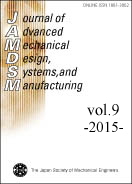Volume 9, Issue 1
Displaying 1-12 of 12 articles from this issue
- |<
- <
- 1
- >
- >|
Papers
-
2015 Volume 9 Issue 1 Pages JAMDSM0001
Published: 2015
Released on J-STAGE: January 06, 2015
Download PDF (1570K) -
2015 Volume 9 Issue 1 Pages JAMDSM0002
Published: 2015
Released on J-STAGE: January 21, 2015
Download PDF (2405K) -
2015 Volume 9 Issue 1 Pages JAMDSM0003
Published: 2015
Released on J-STAGE: January 26, 2015
Download PDF (1507K) -
2015 Volume 9 Issue 1 Pages JAMDSM0004
Published: 2015
Released on J-STAGE: January 26, 2015
Download PDF (1766K) -
2015 Volume 9 Issue 1 Pages JAMDSM0005
Published: 2015
Released on J-STAGE: January 26, 2015
Download PDF (1759K) -
2015 Volume 9 Issue 1 Pages JAMDSM0006
Published: 2015
Released on J-STAGE: March 03, 2015
Download PDF (1956K) -
2015 Volume 9 Issue 1 Pages JAMDSM0007
Published: 2015
Released on J-STAGE: March 09, 2015
Download PDF (1812K)
Technical Note
-
2015 Volume 9 Issue 1 Pages JAMDSM0008
Published: 2015
Released on J-STAGE: March 17, 2015
Download PDF (1065K)
Papers
-
2015 Volume 9 Issue 1 Pages JAMDSM0009
Published: 2015
Released on J-STAGE: March 17, 2015
Download PDF (1601K) -
2015 Volume 9 Issue 1 Pages JAMDSM0010
Published: 2015
Released on J-STAGE: March 19, 2015
Download PDF (4303K) -
2015 Volume 9 Issue 1 Pages JAMDSM0011
Published: 2015
Released on J-STAGE: March 23, 2015
Download PDF (1901K) -
2015 Volume 9 Issue 1 Pages JAMDSM0012
Published: 2015
Released on J-STAGE: March 24, 2015
Download PDF (1530K)
- |<
- <
- 1
- >
- >|
